Simply space! How the Lakhta Center planetarium works
In 2017, the NBA star Shaquille O'Neill almost turned the foundations of the modern view of the world, doubting that the Earth is round. “I constantly travel from Florida to California, so it’s flat for me. After all, I do not move up and down at an angle of 360 degrees. You want to say that China is below us? This is not true. The earth is flat, ”the basketball player substantiated his position. True, he later admitted that in this way he trolled his colleague from Cleveland Kairi Irving, who before that had also expressed doubts about the shape of the Earth.

Fortunately, there have always been many more inquisitive minds in the world at all times. Therefore, the heliocentric model of the world appeared in the Renaissance. And, despite the fact that for the teachings of Copernicus they burned for a very long time at the stake, it eventually won.

When a scientist comes to understand how something is arranged, you immediately want to turn this “something” into a model in order to explain the theory and transfer knowledge. So the first planetarium appeared, later called Copernicus. Of course, mechanical. The principle is elementary: using a set of shafts and gears, planet balls move around the central globe of the Sun, observing the same relative speeds and distances as in the sky.
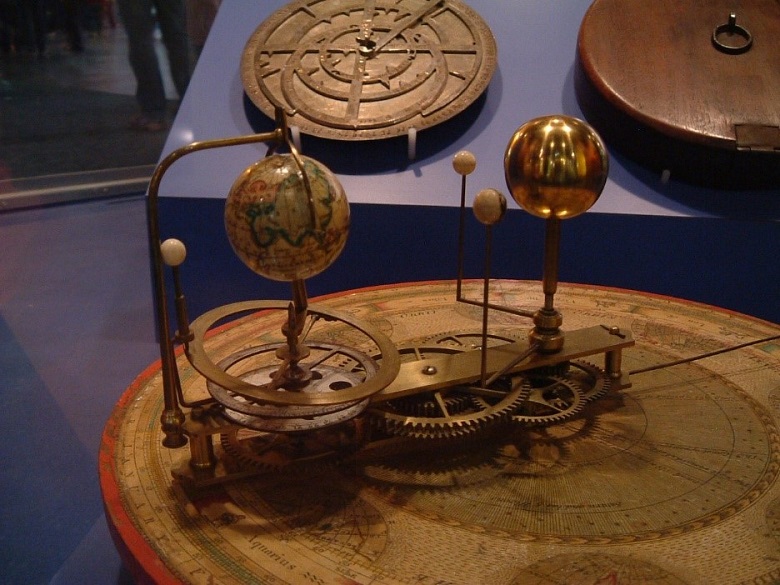
Visually, but not spectacular. Therefore, the prototype of modern planetariums was their other form - the sphere inside which viewers observe the stars and constellations drawn on the moving inner surface of the dome. This design was called the Ptolemaic planetarium. An example is the Great Gottorp Globe of Peter I, exhibited at the Kunstkamera.
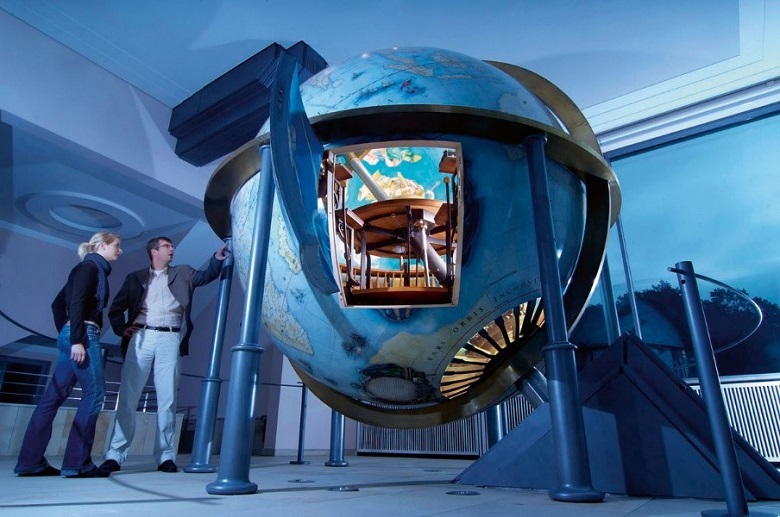
This is already very similar to the planetarium we are used to. Only now, with the accuracy of transmitting the location of stars and planets, there was a problem that was solved at the beginning of the 20th century. To do this, another small revolution was needed - this time in thinking, because the idea that it was better not to flash the stars on the moving dome, but to project them onto a fixed spherical screen did not immediately come to the inventors. Only in 1919 did the German mechanical engineer Walter Bowersfeld propose this breakthrough idea, which was implemented by Carl Zeiss in 1924. The heart of the project was a special optical-mechanical projector, called Zeiss I.
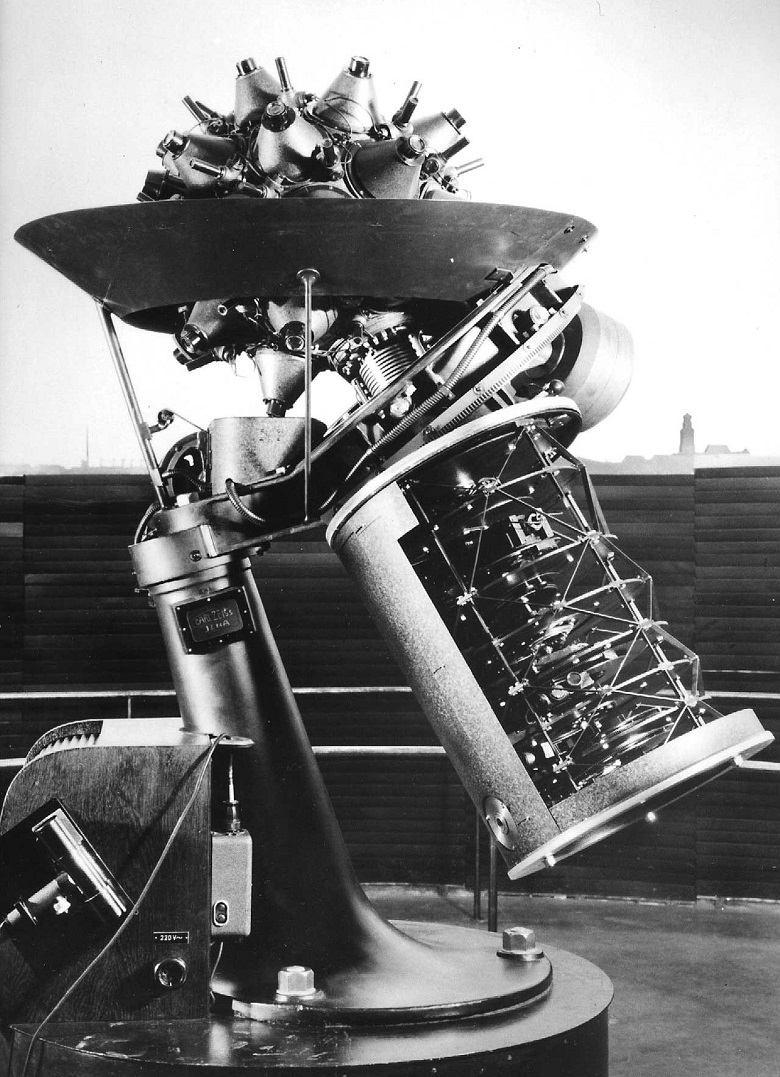
The difference between a new type of planetarium and its predecessors is the ability to reproduce an accurate map of the starry sky visible from anywhere on the earth's surface. To do this, in the "star machine" images of stars are created by tiny holes in copper foil. The light passing through them is transmitted to the dome screen using multiple projectors. Later Zeiss I was improved. Zeiss II already contained two balls, one of which projected the northern celestial hemisphere, and the second - the southern one.
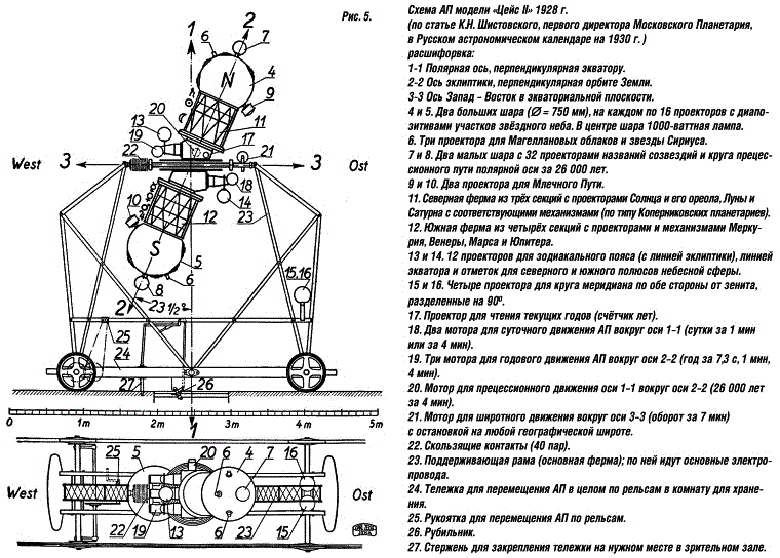
In this form, the planetarium has survived to the present day, and in most astronomical scientific and cognitive objects such star machines operate - somewhere improved, somewhere not really.
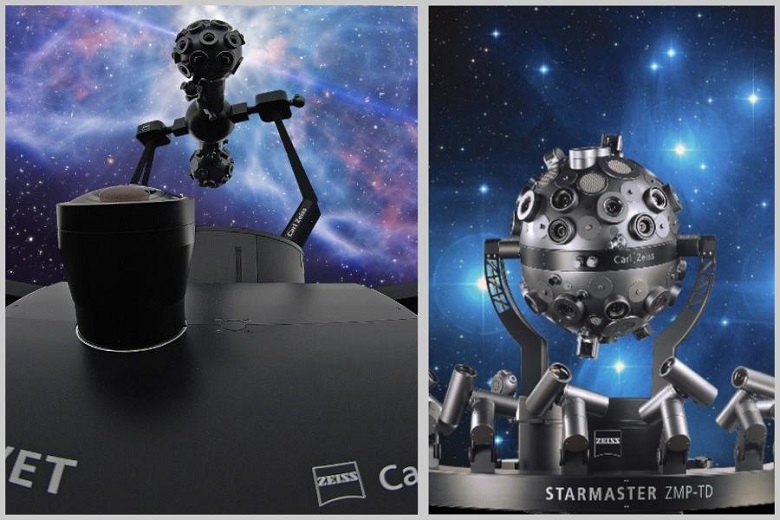
The advent of digital technology has introduced a new wave in the development of planetariums.
Demonstration of the starry sky is now complemented by full-dome videos, laser shows, and in some new planetariums they completely abandoned the use of star machines, replacing them with digital or laser video projectors that broadcast the image that is generated by a computer.
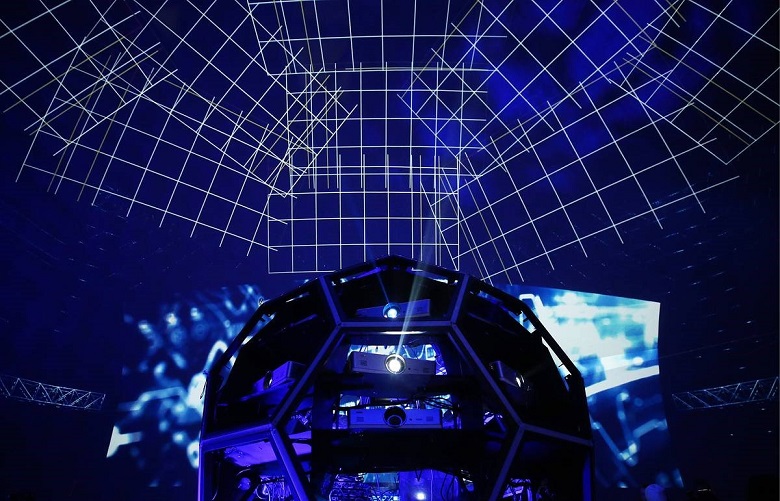
The advantage of fully digital planetariums is their comparatively low price and high entertainment. But experts are inclined to attribute even the most advanced versions of such objects to cinemas with a hemisphere screen that does not have a special relationship with science. The fact is that not a single projection system has yet achieved the image quality of a starry sky comparable to a stellar machine. It's simple: the human eye even discerns stars with very small angular sizes - smaller than the pixel of a projector of the highest resolution. So, these stars cannot be reproduced without a high-quality star machine.
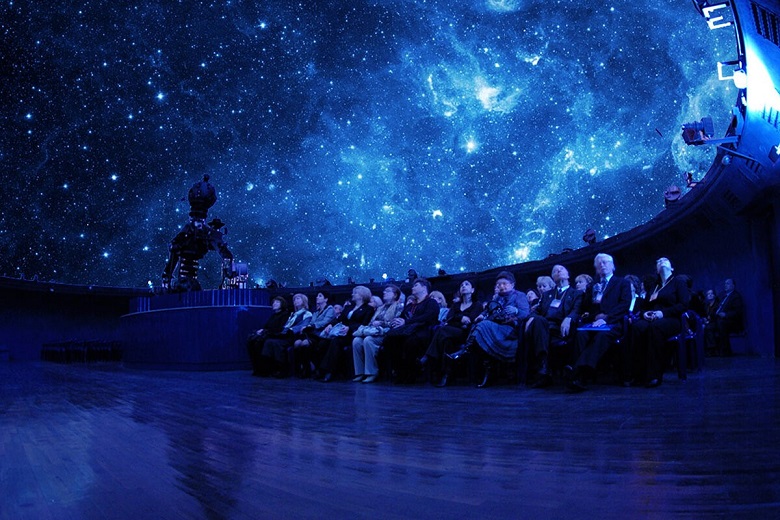
Another thing is that a stellar machine can play nothing but stars. Therefore, in the Lakhta Center planetarium, it was decided to combine the work of a traditional star machine with the capabilities of a digital super cinema.
Before you get acquainted with the equipment of the Lakhta Center planetarium, it is worth taking a look at it from the outside. This is really a sight, because the 19-meter sparkling ball of the star hall will “soar” in the air, slightly protruding from the plane of the glass facade of the atrium of the MFZ.
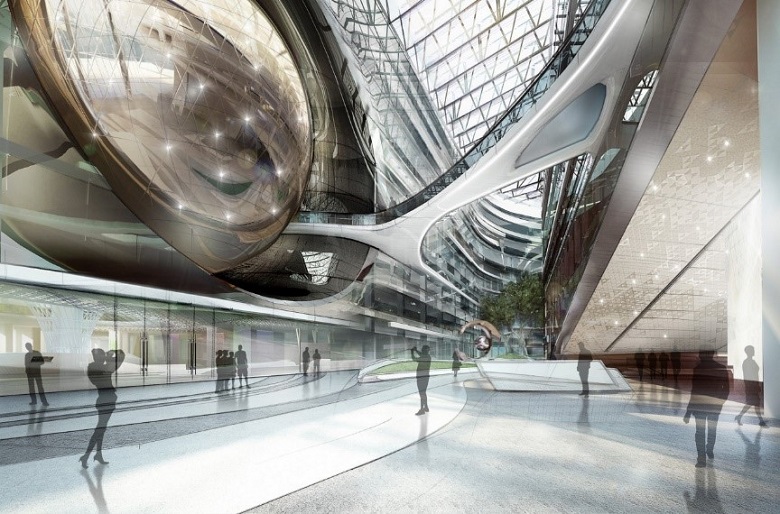
The ball is assembled from polished triangular stainless sheets on a tubular structure and rests on a supporting steel column. Its facade is made of curved glass, between it and the planetary ball remains a gap of 1.5 meters.
The complexity of implementing such an architectural and technical solution is justified by the visual effect - it will be amazing.
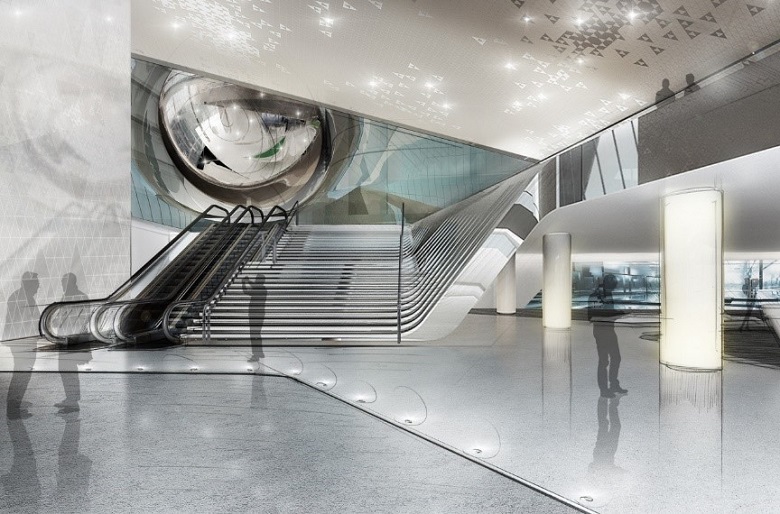

To make the ball so smoothly and beautifully “land” in the glass surface of the facade of the atrium, it was necessary to make 268 thermo-curved glasses for a niche - each of them was given a given shape. But visually these are the same glasses as in the entire space of the Atrium - the same in quality of transparency and the absence of distortion.
For this, a bending process is used, based on the ability of glass heated to a temperature of 600–700 ° C to become “flowing” and slowly deform under the weight of its own weight, taking the form of a supporting surface with a given geometry. At the same time, the glass sheet maintains integrity and smoothness.
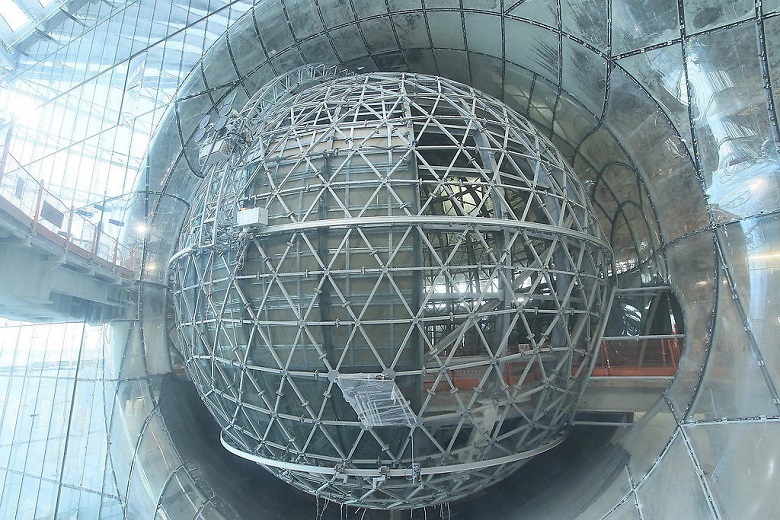
The decoration of the facade of the planetarium ball is planned brightly and stylishly. On the surface of 1,223 curved triangular stainless steel sheets polished to a high gloss.
These triangles will be installed in the last turn - carefully and in white gloves. They will create the “cosmic” impression of the object.
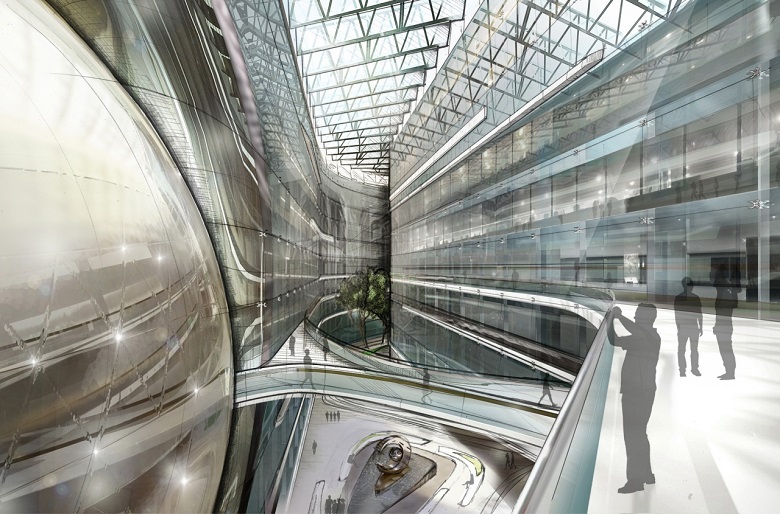
The Lakhta Center Planetarium is not only a star hall, but also a vast public space around it, which in itself can be a point of attraction.
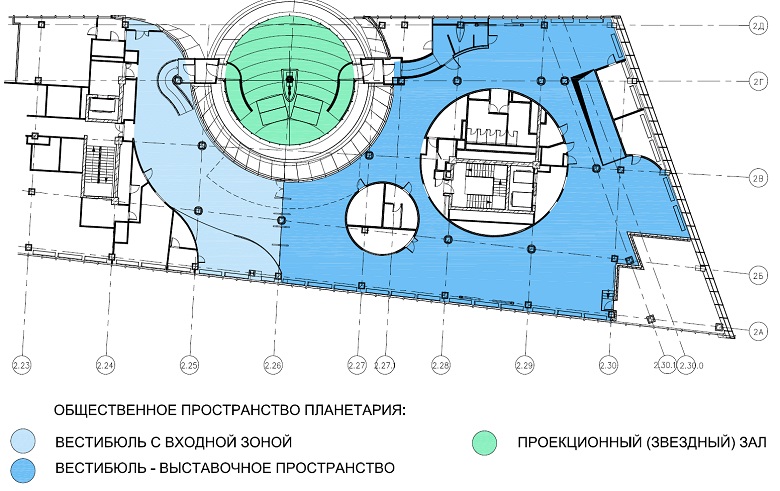
Like any spectacular sight, the Lahti planetarium begins with a hanger. More precisely - with an automatic wardrobe. Automatic means fast: there’s only enough time to find out the schedule of the next shows, which will be broadcast on monitors located in this zone.
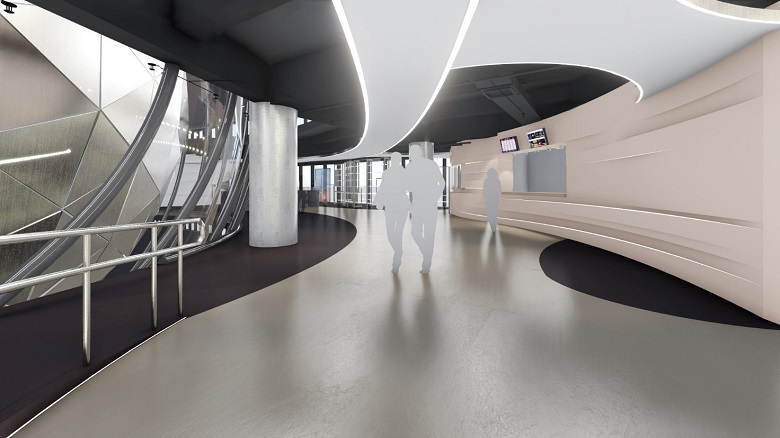
After going inside and buying tickets, visitors cease to manage their lives until the end of the session. The public area is designed to guide people along the path chosen by the designers. This is the most interesting way: there is also a zone for photo shoots; and audio-video studios; and the server room with a large panoramic window - you can see with your own eyes how the computer heart of the planetarium beats; here and media screens created using flexible OLED panels.
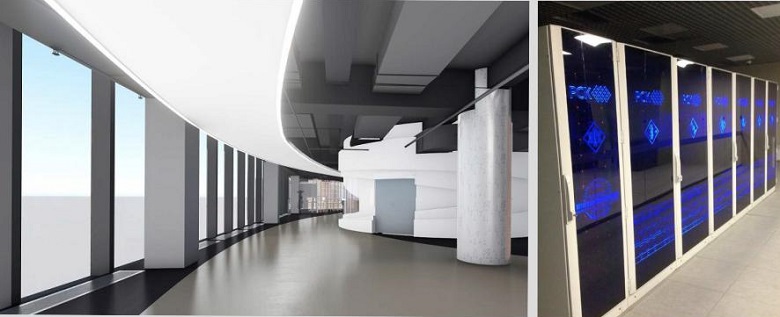
Due to MultiTouch technology with interactive applications, even multiple visitors can interact with video walls even on one screen: play educational games, watch reference books or get acquainted with presentations and infographics.
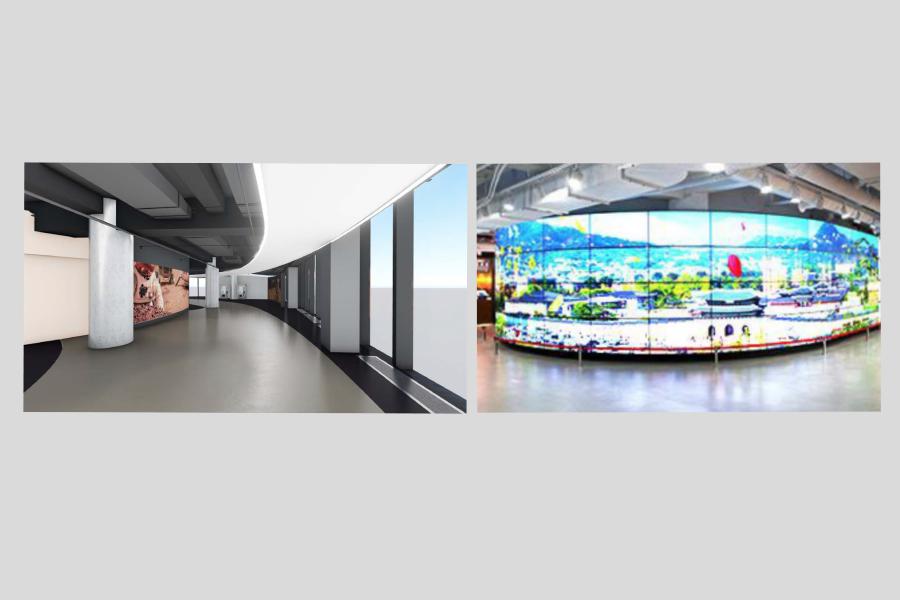
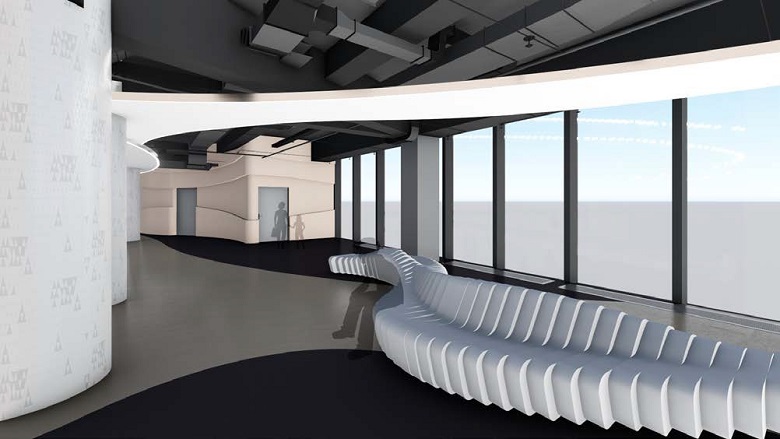
In the waiting room - the final part of the foyer - dim lights, media screens with dimly changing static images are placed on the walls, soft music sounds - all in order to prepare a person for the most important thing: behind this zone is the entrance to the star hall.
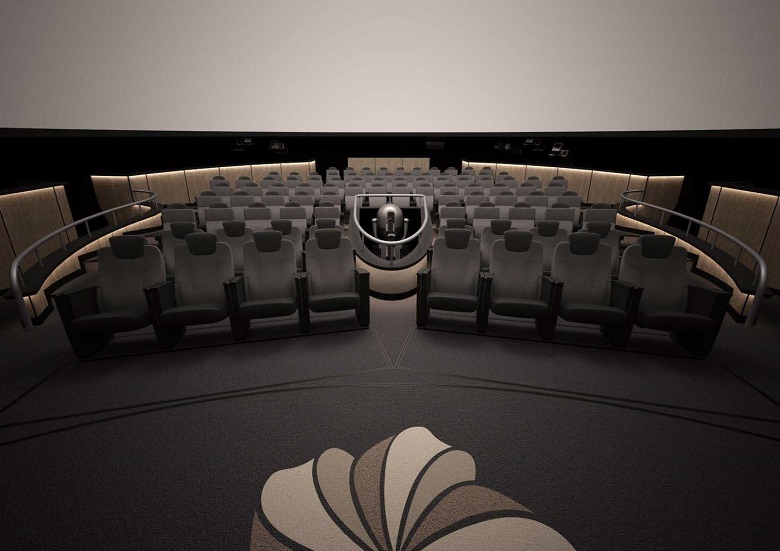
As you can see, the star machine is in place, it’s immediately clear - we are in a real planetarium. This is one of the most advanced optical-mechanical projectors in the world today - the Japanese Ohira Tech Megastar-IIA.
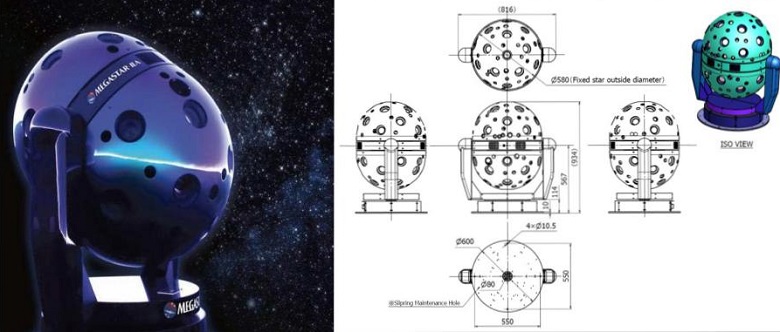
The stellar machine of the planetarium Lakhta Center is a whole complex consisting of a stellar ball and additional optical-mechanical projectors of the Sun, Moon and planets. In addition to a billion stars, the largest of which are colored and flickering, Ohira Tech Megastar can realistically display nebulae.
For the correct display of the starry sky, the center of the machine should be in the center of the geometric screen. Therefore, the star ball will be installed exactly in the center of the dome on the elevator to raise the projector to the level of the dome horizon and lower it as low as possible when not in use.
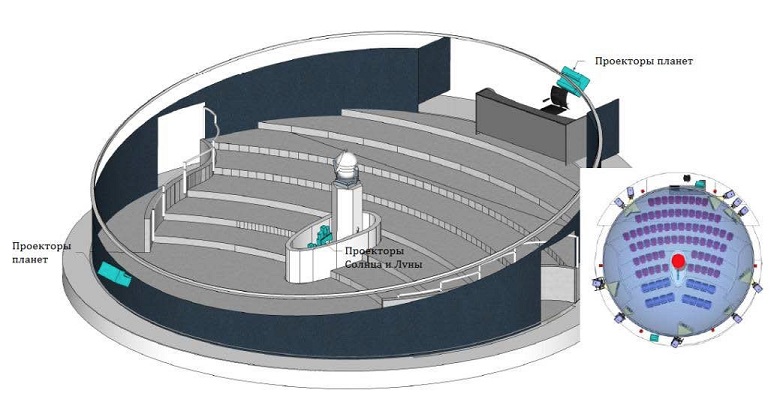
But no matter how advanced the star machine, to create a world-class scientific-educational and entertainment program, it needs an addition in the form of a system of digital projectors. In the Lakhta Center planetarium, this is not even an addition: mechanics and numbers are in equal rights, and it is the integrated use of the most advanced equipment of both types that makes the object unique. The exact projection of the starry sky is formed by a stellar machine, and larger objects, artificial aircraft, visual effects and much more are digital ones created by a projection system with a resolution of 8K along the meridian, for which 10 SONY GTZ280 laser projectors are used.
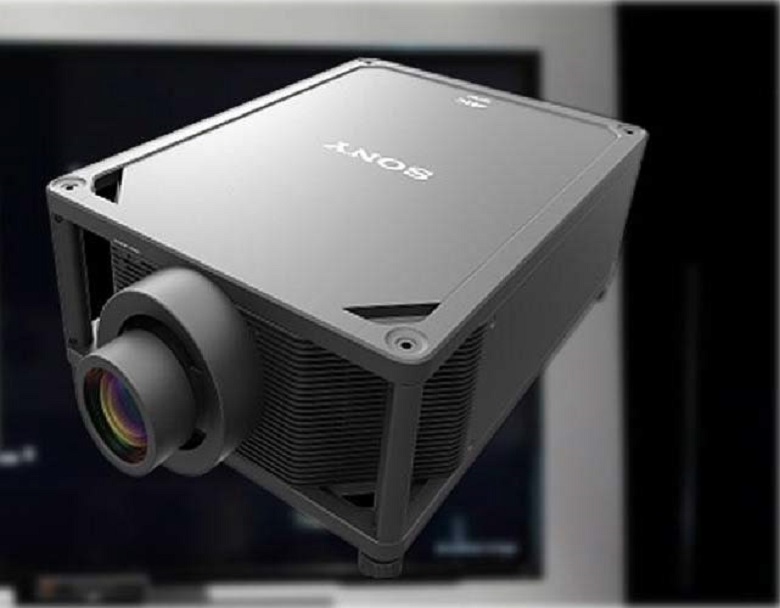
Five projectors illuminate the lower tier of the dome, four - the upper, and one forms an image at the zenith. Thus, a total resolution of 48,483,533 pixels is achieved.
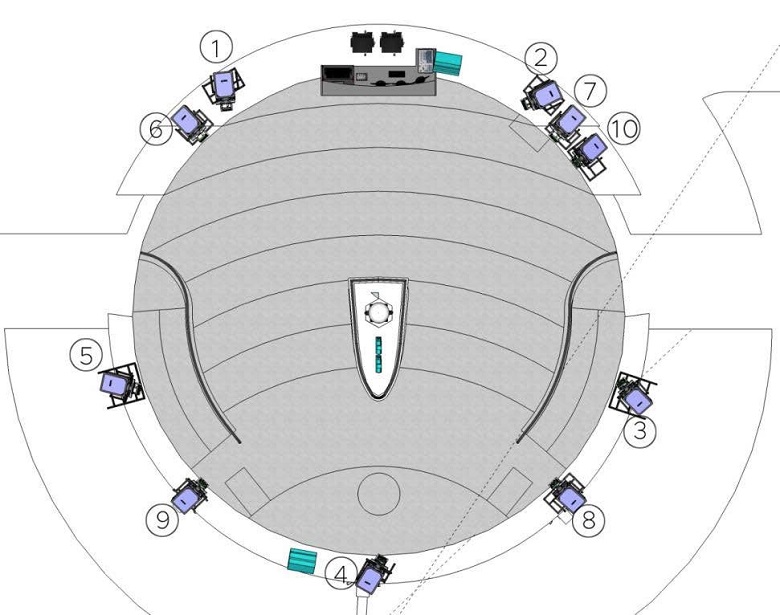
Of course, it’s important not only how to show, but also what. The Sky Explorer astrosimulator from the French company RCA Cosmos answers this question, which controls the playback of content from projectors, synchronizes it with the image formed by the star machine and, if necessary, can control the “starball”. At the same time, the operating system for controlling the stellar machine can interact with Sky Explorer in the opposite direction. This is the unique hybridity of the Lakhta Center planetarium. The host directly during the show from the tablet can control what the audience sees, for example, show the view of the Earth from space and demonstrate its internal structure.
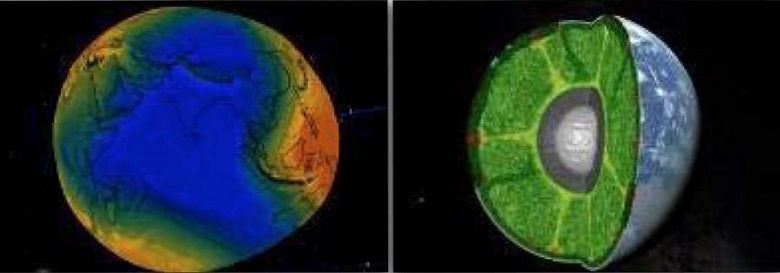
Take a trip through the solar system.

Or fly through a three-dimensional model of the galaxy, look at it from the side. Moreover, this is a scientific model of the Milky Way, which can be displayed in different wave spectra and includes many details, such as dust and gas.
In real time, light emission, its scattering and attenuation are modeled in accordance with the spectral characteristics of objects, which gives an accurate and spectacular picture.

You can see how the black hole is arranged. Also with the help of a scientific model that includes dynamic realistic distortion of space-time.
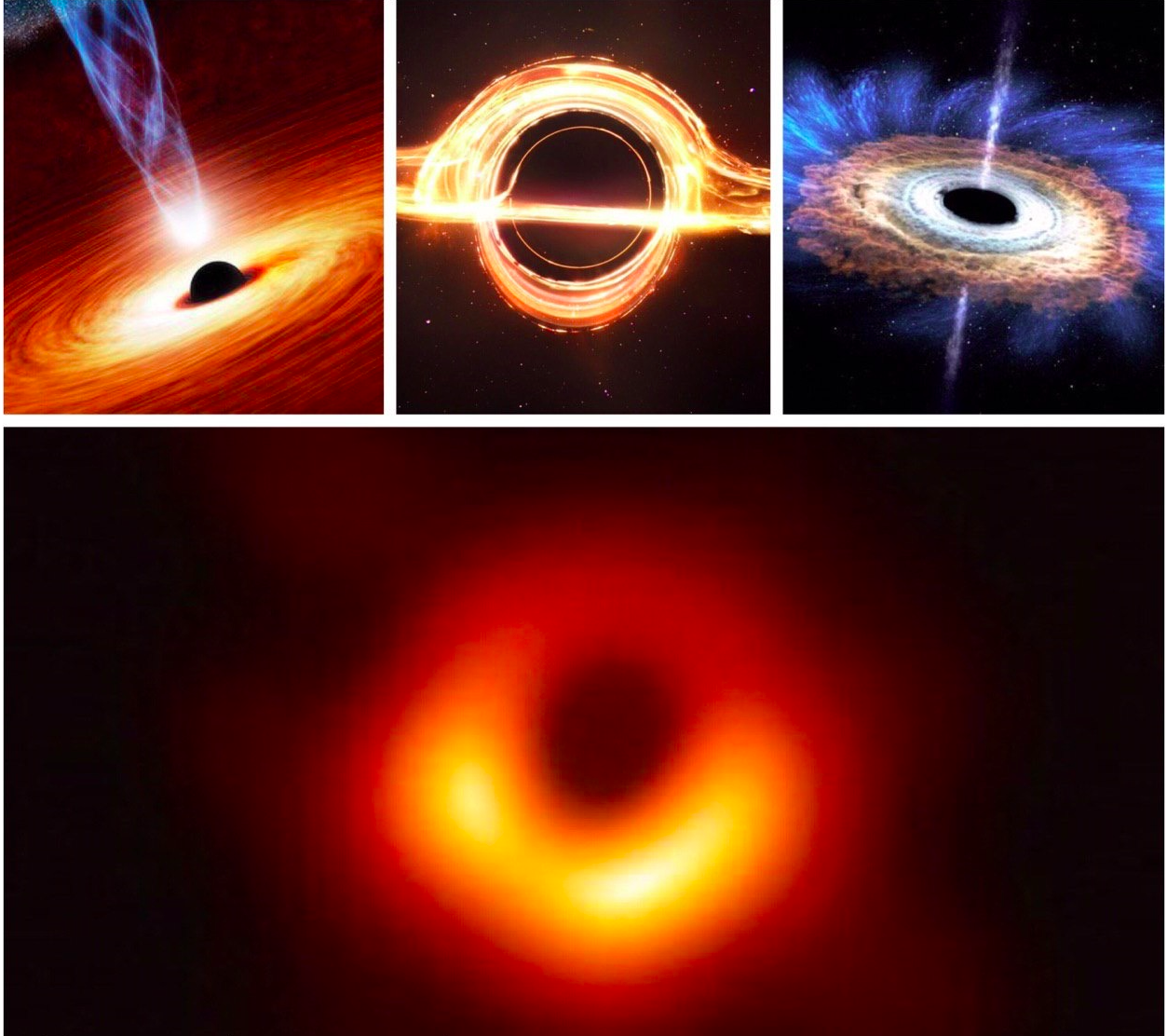
Black hole: expectation and reality
The Sky Explorer library includes a satellite base, 400 thousand asteroids (ASTORB from Lowel Observatory) with real-time display of objects. And all this is not fixed content - the library is regularly updated.

The base of artificial Earth satellites and the base of asteroids
A, you can just watch cartoons.

For greater reliability, Sky Explorer has a double - a backup full-dome digital system with which you can play video from a computer using the projectors of the main system. It is implemented on a specialized integrated solution from Front Pictures, operating on the basis of Screenberry360 Media server.
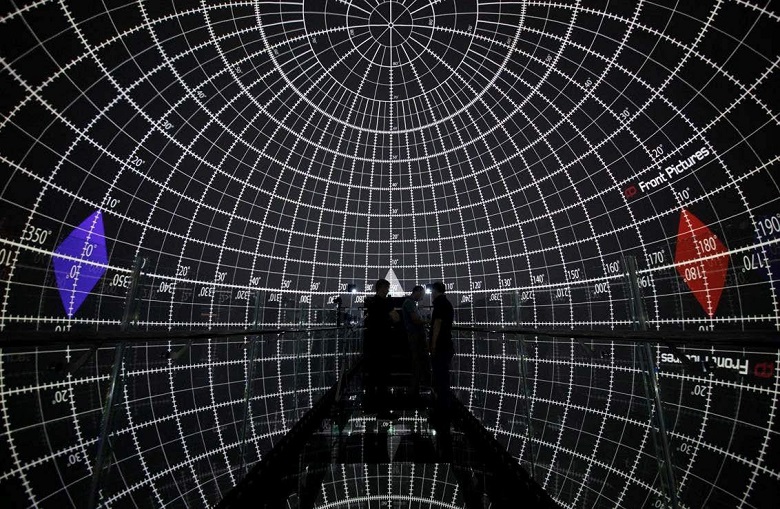
In addition to the questions “How?” And “What?”, There is also the question “Where?”. The dome screen of the planetarium is far from the largest - 14 meters, but, like the other components of the object, is super-technological. It is made of ultra-light perforated material by Astro-tec using Ulteria Seam technology, which involves joining the plates of the screen “butt-to-butt”, which makes its surface almost seamless. This is the first such screen in Russia.
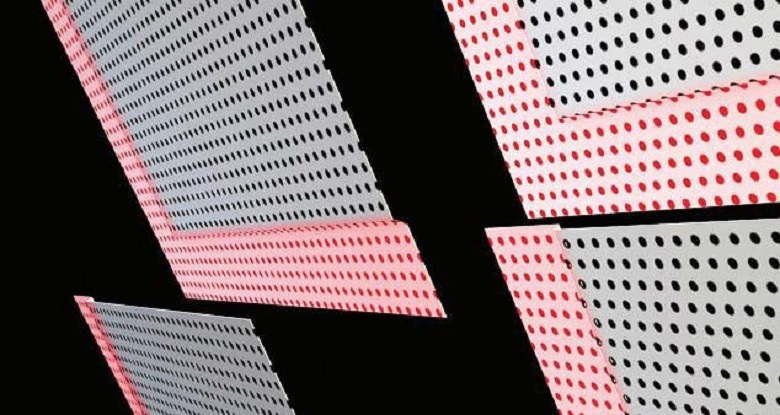
The dome is not mounted on columns, as is usually done, but suspended on chains.
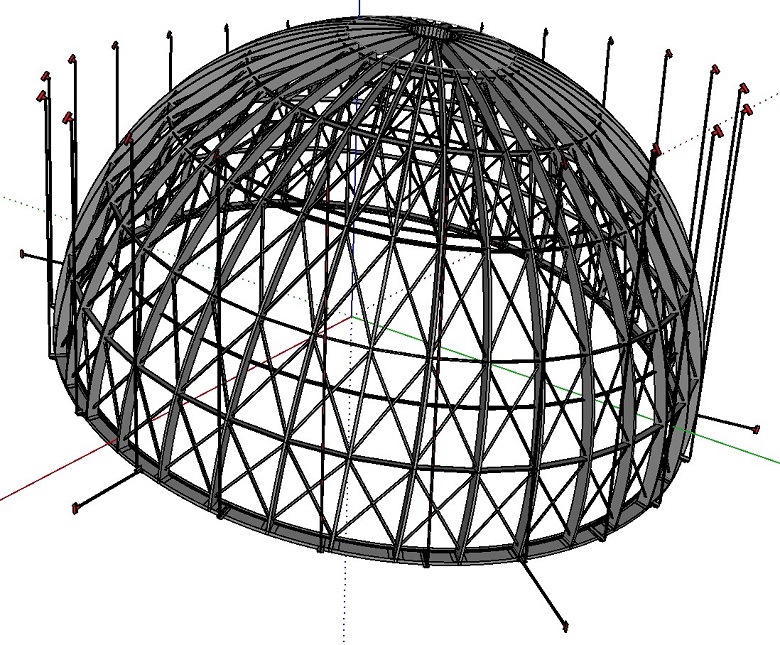
Thanks to this decision, it was possible to place a lot of equipment in the star room: 10 Sky Explorer projectors, 6 laser projectors, 3 video cameras, 5 auto-calibration cameras, a hi-end 14.2 Meyer Sound surround sound system.
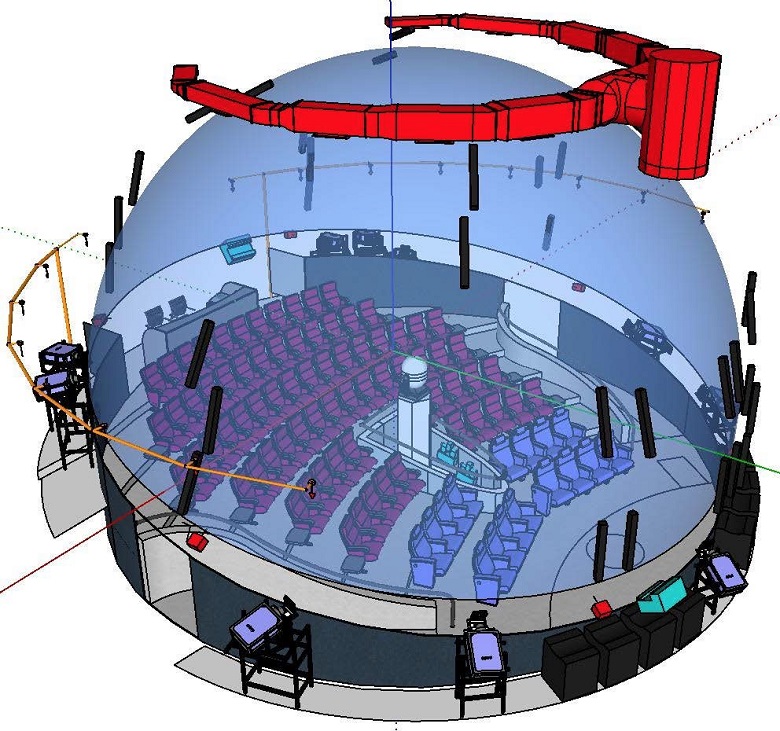
Why so much? For versatility. A planetarium with such equipment can be used not only for its intended purpose, but also as a super-technology venue for events. A scene transformation mechanism is installed here, part of the seats automatically folds to form a flat surface.
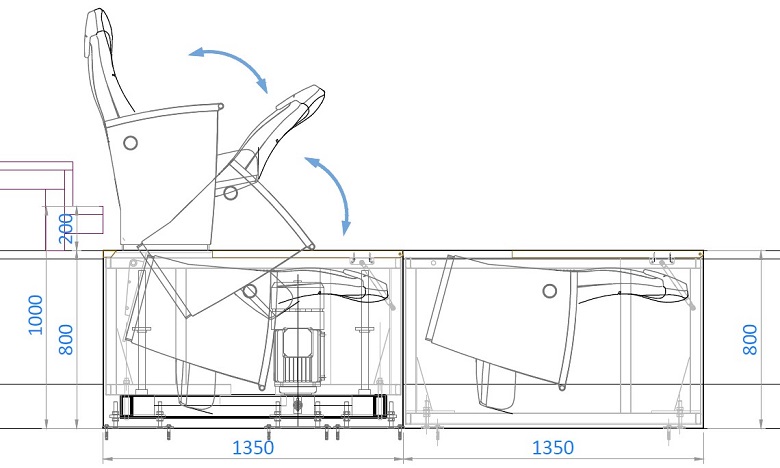
For example, concerts can be held here - there is a mixing console, a system of microphones, the sound from which is output to the operator’s place and to the recording studio, all the necessary interfaces for connecting musicians' equipment are provided. The sound will be lively and deep, because on the basis of acoustic modeling of the interior of the star hall, it was decided to use panels veneered with a tree with a unique relief in the decoration.
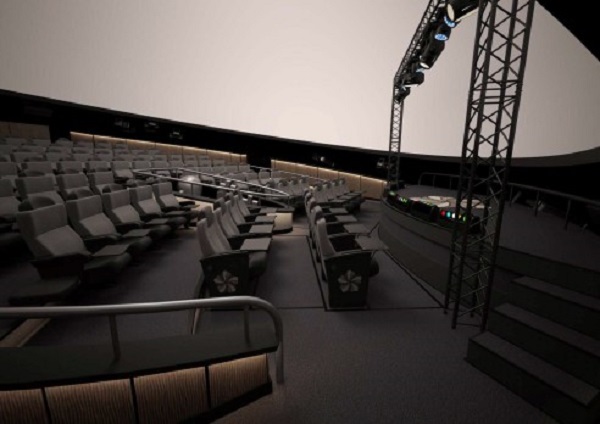
Well, and what concert without stage effects? Controlled lighting fixtures are installed on a removable farm, and the smoke show laser show system completes this set of tools.
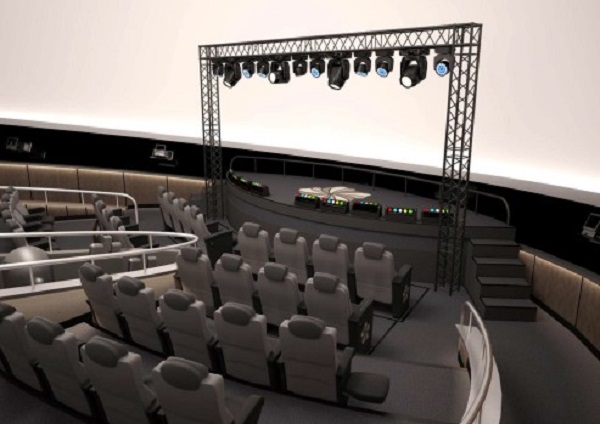
But still, the planetarium in the first place is a journey to the stars. So we take places, we fasten ourselves and - Don’t Panic, as they say in the most famous guide to the galaxy!

***
Thank you for your help in preparing the material of the specialists of IFC Lakhta Center JSC: Igor Romanenko - leading engineer of construction control, Dmitry Matveev - head of the department for metal and facade structures, Gelen Ermakov - chief specialist architect; as well as colleagues from AviLab - Alexander Zhirnov and Petr Brusentsev.

Fortunately, there have always been many more inquisitive minds in the world at all times. Therefore, the heliocentric model of the world appeared in the Renaissance. And, despite the fact that for the teachings of Copernicus they burned for a very long time at the stake, it eventually won.

How to model the universe
When a scientist comes to understand how something is arranged, you immediately want to turn this “something” into a model in order to explain the theory and transfer knowledge. So the first planetarium appeared, later called Copernicus. Of course, mechanical. The principle is elementary: using a set of shafts and gears, planet balls move around the central globe of the Sun, observing the same relative speeds and distances as in the sky.

Visually, but not spectacular. Therefore, the prototype of modern planetariums was their other form - the sphere inside which viewers observe the stars and constellations drawn on the moving inner surface of the dome. This design was called the Ptolemaic planetarium. An example is the Great Gottorp Globe of Peter I, exhibited at the Kunstkamera.

This is already very similar to the planetarium we are used to. Only now, with the accuracy of transmitting the location of stars and planets, there was a problem that was solved at the beginning of the 20th century. To do this, another small revolution was needed - this time in thinking, because the idea that it was better not to flash the stars on the moving dome, but to project them onto a fixed spherical screen did not immediately come to the inventors. Only in 1919 did the German mechanical engineer Walter Bowersfeld propose this breakthrough idea, which was implemented by Carl Zeiss in 1924. The heart of the project was a special optical-mechanical projector, called Zeiss I.

The difference between a new type of planetarium and its predecessors is the ability to reproduce an accurate map of the starry sky visible from anywhere on the earth's surface. To do this, in the "star machine" images of stars are created by tiny holes in copper foil. The light passing through them is transmitted to the dome screen using multiple projectors. Later Zeiss I was improved. Zeiss II already contained two balls, one of which projected the northern celestial hemisphere, and the second - the southern one.

In this form, the planetarium has survived to the present day, and in most astronomical scientific and cognitive objects such star machines operate - somewhere improved, somewhere not really.

The figure against mechanics
The advent of digital technology has introduced a new wave in the development of planetariums.
Demonstration of the starry sky is now complemented by full-dome videos, laser shows, and in some new planetariums they completely abandoned the use of star machines, replacing them with digital or laser video projectors that broadcast the image that is generated by a computer.

The advantage of fully digital planetariums is their comparatively low price and high entertainment. But experts are inclined to attribute even the most advanced versions of such objects to cinemas with a hemisphere screen that does not have a special relationship with science. The fact is that not a single projection system has yet achieved the image quality of a starry sky comparable to a stellar machine. It's simple: the human eye even discerns stars with very small angular sizes - smaller than the pixel of a projector of the highest resolution. So, these stars cannot be reproduced without a high-quality star machine.

Another thing is that a stellar machine can play nothing but stars. Therefore, in the Lakhta Center planetarium, it was decided to combine the work of a traditional star machine with the capabilities of a digital super cinema.
Ball in the wall - uniqueness begins with the appearance
Before you get acquainted with the equipment of the Lakhta Center planetarium, it is worth taking a look at it from the outside. This is really a sight, because the 19-meter sparkling ball of the star hall will “soar” in the air, slightly protruding from the plane of the glass facade of the atrium of the MFZ.

The ball is assembled from polished triangular stainless sheets on a tubular structure and rests on a supporting steel column. Its facade is made of curved glass, between it and the planetary ball remains a gap of 1.5 meters.
The complexity of implementing such an architectural and technical solution is justified by the visual effect - it will be amazing.

Igor Romanenko, Leading Engineer of Construction Control:
“As conceived by architects, a planetarium ball“ hovers ”in the air. The task of the designers was to "hide" the place of support, fastening the ball to the ceilings. Visitors to the complex will not see him. The fastenings are hidden in the central column and in the entrance bridges inside the ball on the fifth floor. ”

To make the ball so smoothly and beautifully “land” in the glass surface of the facade of the atrium, it was necessary to make 268 thermo-curved glasses for a niche - each of them was given a given shape. But visually these are the same glasses as in the entire space of the Atrium - the same in quality of transparency and the absence of distortion.
For this, a bending process is used, based on the ability of glass heated to a temperature of 600–700 ° C to become “flowing” and slowly deform under the weight of its own weight, taking the form of a supporting surface with a given geometry. At the same time, the glass sheet maintains integrity and smoothness.
Dmitry Matveev, the head of the department for metal and facade structures:
- For the glazing of a niche in which the planetarium “hovers”, a special remote-controlled manipulator mechanism has been developed. It is mounted on the construction of the planetary ball itself, and was used to install double-glazed windows in hard-to-reach parts of the niche.

The decoration of the facade of the planetarium ball is planned brightly and stylishly. On the surface of 1,223 curved triangular stainless steel sheets polished to a high gloss.
These triangles will be installed in the last turn - carefully and in white gloves. They will create the “cosmic” impression of the object.
Gelena Ermakova, chief specialist architect:
- Diode lamps are installed at the vertices of the triangles of the exterior decoration of the ball. Changing the tonality and brightness, they highlight the sphere and create the effect of a starry sky on the surface of a planetarium ball. We can say that in our planetarium it will be possible to see stars not only inside, but also outside.

The Lakhta Center Planetarium is not only a star hall, but also a vast public space around it, which in itself can be a point of attraction.

Road to the stars
Like any spectacular sight, the Lahti planetarium begins with a hanger. More precisely - with an automatic wardrobe. Automatic means fast: there’s only enough time to find out the schedule of the next shows, which will be broadcast on monitors located in this zone.

After going inside and buying tickets, visitors cease to manage their lives until the end of the session. The public area is designed to guide people along the path chosen by the designers. This is the most interesting way: there is also a zone for photo shoots; and audio-video studios; and the server room with a large panoramic window - you can see with your own eyes how the computer heart of the planetarium beats; here and media screens created using flexible OLED panels.

Due to MultiTouch technology with interactive applications, even multiple visitors can interact with video walls even on one screen: play educational games, watch reference books or get acquainted with presentations and infographics.


In the waiting room - the final part of the foyer - dim lights, media screens with dimly changing static images are placed on the walls, soft music sounds - all in order to prepare a person for the most important thing: behind this zone is the entrance to the star hall.
Unique hybrid

As you can see, the star machine is in place, it’s immediately clear - we are in a real planetarium. This is one of the most advanced optical-mechanical projectors in the world today - the Japanese Ohira Tech Megastar-IIA.

The stellar machine of the planetarium Lakhta Center is a whole complex consisting of a stellar ball and additional optical-mechanical projectors of the Sun, Moon and planets. In addition to a billion stars, the largest of which are colored and flickering, Ohira Tech Megastar can realistically display nebulae.
For the correct display of the starry sky, the center of the machine should be in the center of the geometric screen. Therefore, the star ball will be installed exactly in the center of the dome on the elevator to raise the projector to the level of the dome horizon and lower it as low as possible when not in use.

But no matter how advanced the star machine, to create a world-class scientific-educational and entertainment program, it needs an addition in the form of a system of digital projectors. In the Lakhta Center planetarium, this is not even an addition: mechanics and numbers are in equal rights, and it is the integrated use of the most advanced equipment of both types that makes the object unique. The exact projection of the starry sky is formed by a stellar machine, and larger objects, artificial aircraft, visual effects and much more are digital ones created by a projection system with a resolution of 8K along the meridian, for which 10 SONY GTZ280 laser projectors are used.

Five projectors illuminate the lower tier of the dome, four - the upper, and one forms an image at the zenith. Thus, a total resolution of 48,483,533 pixels is achieved.

Just cosmos
Of course, it’s important not only how to show, but also what. The Sky Explorer astrosimulator from the French company RCA Cosmos answers this question, which controls the playback of content from projectors, synchronizes it with the image formed by the star machine and, if necessary, can control the “starball”. At the same time, the operating system for controlling the stellar machine can interact with Sky Explorer in the opposite direction. This is the unique hybridity of the Lakhta Center planetarium. The host directly during the show from the tablet can control what the audience sees, for example, show the view of the Earth from space and demonstrate its internal structure.

Take a trip through the solar system.

Or fly through a three-dimensional model of the galaxy, look at it from the side. Moreover, this is a scientific model of the Milky Way, which can be displayed in different wave spectra and includes many details, such as dust and gas.
In real time, light emission, its scattering and attenuation are modeled in accordance with the spectral characteristics of objects, which gives an accurate and spectacular picture.

You can see how the black hole is arranged. Also with the help of a scientific model that includes dynamic realistic distortion of space-time.

Black hole: expectation and reality
The Sky Explorer library includes a satellite base, 400 thousand asteroids (ASTORB from Lowel Observatory) with real-time display of objects. And all this is not fixed content - the library is regularly updated.

The base of artificial Earth satellites and the base of asteroids
A, you can just watch cartoons.

For greater reliability, Sky Explorer has a double - a backup full-dome digital system with which you can play video from a computer using the projectors of the main system. It is implemented on a specialized integrated solution from Front Pictures, operating on the basis of Screenberry360 Media server.

Seamless
In addition to the questions “How?” And “What?”, There is also the question “Where?”. The dome screen of the planetarium is far from the largest - 14 meters, but, like the other components of the object, is super-technological. It is made of ultra-light perforated material by Astro-tec using Ulteria Seam technology, which involves joining the plates of the screen “butt-to-butt”, which makes its surface almost seamless. This is the first such screen in Russia.

The dome is not mounted on columns, as is usually done, but suspended on chains.

Thanks to this decision, it was possible to place a lot of equipment in the star room: 10 Sky Explorer projectors, 6 laser projectors, 3 video cameras, 5 auto-calibration cameras, a hi-end 14.2 Meyer Sound surround sound system.

Stars on the dome and on stage
Why so much? For versatility. A planetarium with such equipment can be used not only for its intended purpose, but also as a super-technology venue for events. A scene transformation mechanism is installed here, part of the seats automatically folds to form a flat surface.

For example, concerts can be held here - there is a mixing console, a system of microphones, the sound from which is output to the operator’s place and to the recording studio, all the necessary interfaces for connecting musicians' equipment are provided. The sound will be lively and deep, because on the basis of acoustic modeling of the interior of the star hall, it was decided to use panels veneered with a tree with a unique relief in the decoration.

Well, and what concert without stage effects? Controlled lighting fixtures are installed on a removable farm, and the smoke show laser show system completes this set of tools.

But still, the planetarium in the first place is a journey to the stars. So we take places, we fasten ourselves and - Don’t Panic, as they say in the most famous guide to the galaxy!

***
Thank you for your help in preparing the material of the specialists of IFC Lakhta Center JSC: Igor Romanenko - leading engineer of construction control, Dmitry Matveev - head of the department for metal and facade structures, Gelen Ermakov - chief specialist architect; as well as colleagues from AviLab - Alexander Zhirnov and Petr Brusentsev.
